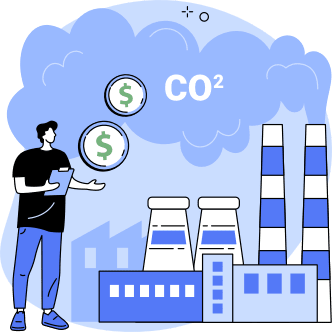Understanding Carbon Markets and Offsets

Voluntary and Compliance Markets: What’s the Difference?
Carbon markets trade in offsets of greenhouse gas emissions. There are two types of carbon markets: Compliance (mandatory regulated programs) and Voluntary (entities engage on their own free will).
Zefiro primarily trades in the voluntary carbon markets. This is because organizations that go “above and beyond” mandated emission reductions represent a higher environmental benefit.
Voluntary carbon markets are overseen by standards organizations (e.g., Verra, American Carbon Registry, Gold Standard) who set minimum quality thresholds for the creation of an offset in order to establish quality assurance.

What are Carbon Offsets?
Carbon offsets are verified reductions in greenhouse gas (“GHG”) emissions. They are transferable instruments which are created by following a methodology laid out by the standards organizations listed above, subject to an audit by a third-party validator.
Offsets can be created from different types of reductions including renewable energy, methane capture, avoided deforestation, and capture of industrial gases. Even though there are numerous different GHGs emitted, each offset represents the equivalent of one metric ton of CO2. Each greenhouse gas has a different GWP (“global warming potential”) which represents how many tons of CO2 would do the same amount of damage to the atmosphere as one ton of that GHG.

What is the “Use Case” for Carbon Offsets?
Many organizations operating at local, national, and global scales have committed to reduce their carbon emissions to “Net Zero”. However, it is very impractical for most organizations to completely eliminate their carbon footprint in the short to medium term. By purchasing offsets, organizations are indirectly funding the projects generating reductions. As they have funded reductions, organizations can retire (remove from circulation) these carbon offsets to neutralize their own emissions. In doing so they can meet their Net Zero Targets without needing to cease operating until appropriate abatement technology develops.

Are all Carbon Offsets the Same?
While all carbon offsets represent the same quantity of CO2 equivalent emissions reduced, some types of offsets may be of higher quality than others. Quality is defined by the level of confidence that one can have in the offset project’s success in reducing emissions that would otherwise have been released into the atmosphere. There are several key factors to consider:
- Additionality is a technical term that refers to a project providing “additional” reductions that would not have occurred without the funding from the carbon offsets;
- Quantification accuracy between project types is not always equal, and as such we can have more confidence in emissions measurements in some project types than others;
- Permanence refers to some types of projects being reversible. This means emissions may recommence later down the line; and
- Leakage can occur when a reduction in one place leads to emissions elsewhere instead.
Regulated reporting and improved market awareness mean that organizations are increasingly seeking high-quality offsets to offset their emissions. As Net Zero target dates draw nearer we expect to see the price of such credits increase to reflect the high level of confidence the market can have in the success of the emissions reductions projects behind them.